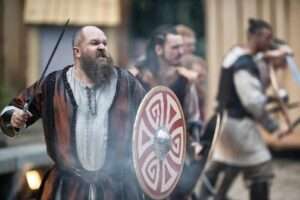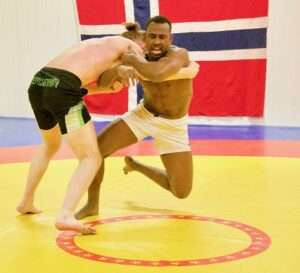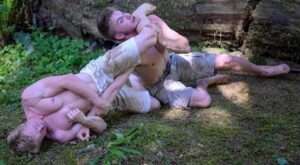Unveiling Iceland’s Viking Legacy.
Glima, a martial art deeply rooted in Icelandic heritage, stands as a testament to the rich Viking legacy. Developed during the Viking Age, Glima has evolved over centuries, shaping the cultural and historical fabric of Iceland. Originating from Scandinavian Vikings, specifically those from Norway, Denmark, and Sweden who settled in Iceland, Glima draws upon their wrestling traditions and embodies the strength, skill, and spirit of the Viking warriors. In this article, I will explore the journey of Glima, tracing its development in Iceland, its significance during the Viking Age, the incorporation of weapons, and its transformation into a contemporary sport.
Iceland and the Development of Glima.

Glima found fertile ground for its development in Iceland, a land forged by Norse settlers. The Scandinavian Vikings who arrived during the Viking Age brought their cultural practices, including wrestling traditions, to the island. The isolation and challenging conditions of Iceland played a crucial role in shaping Glima as a practical form of self-defense, emphasizing technique, agility, and adaptability.
Glima in the Viking Age.
During the Viking Age, Glima held significant importance within Icelandic society. Viking warriors engaged in intense physical combat, and Glima provided them with valuable combat skills. While Glima primarily focused on wrestling and grappling techniques, it is essential to recognize that Viking warriors also utilized weapons during battle. Swords, axes, spears, and shields were wielded with prowess, showcasing the Vikings’ versatility and strategic capabilities on the battlefield.
Weapons in Glima.

While Glima’s foundation lies in unarmed combat, historical weapons played a role in Viking warfare and influenced martial arts. The Vikings brought their weapon traditions from their respective homelands. Swords, with their sharp double-edged blades, axes with bearded edges, spears for thrusting and throwing, and sturdy shields formed a part of the Viking warrior’s arsenal.
Glima as a Sport.

Today, Glima has transformed into a celebrated sport that embraces its Viking origins while adapting to modern times. As a sport, Glima retains its essence as an unarmed combat form, emphasizing technique, agility, and balance. Competitors engage in controlled bouts, showcasing their skill in throws, and strategic maneuvers. Glima tournaments, championships, and training programs have gained popularity, attracting participants from Iceland and beyond. The sport not only promotes physical fitness but also fosters a connection to Iceland’s cultural heritage and the Viking era.
Glima serves as a reminder of the indomitable spirit and physical prowess of the Viking warriors, preserving their legacy through a living martial art form. The incorporation of Glima into modern sports allows participants and spectators to appreciate the historical roots of Iceland and its Viking heritage. The dedication to technique, respect for tradition, and the pursuit of physical excellence embody the values upheld by the ancient Vikings.
Types of Glima.
Brókartök.
Brókartök (Trouser-Grip Wrestling): Brókartök is the most widespread and popular form of Glima in Iceland. It emphasizes technique over strength and is considered Iceland’s national sport. Competitors wear a special belt around the waist and additional belts on the lower thighs, which are connected to the main belt. They grip their opponent with one hand on the belt and the other on the trousers at thigh height. The objective is to trip and throw the opponent, with the winning condition being to make the opponent touch the ground with an area of the body between the elbow and the knee.
Hryggspenna.
Hryggspenna (Backhold Wrestling): Hryggspenna is a form of Glima that focuses on holding the upper body of the opponent. Competitors grip each other’s upper body, and the objective is to make the opponent touch the ground with any part of their body except their feet. Hryggspenna is often regarded as a test of strength, highlighting the physical prowess of the participants.
Lausatök.

Lausatök (Loose-Grip Wrestling): Lausatök allows contestants to use any holds they wish, offering more freedom compared to other forms of Glima. It can be practiced in two distinct versions:
a. Friendly Competition: This version is practiced with the intention of friendly competition and emphasizes executing techniques without causing injury. Participants aim to make their opponent touch the ground, and the winner is determined by the one who remains standing while the other is lying on the ground.
b. Self-Defense: In self-defence-oriented Lausatök, participants explore various techniques, including those that may be harmful or hurtful. This form of Glima encourages creativity and freedom in executing techniques while still maintaining a focus on self-defense.
Glima, originating from the Scandinavian Vikings who settled in Iceland during the Viking Age, holds a significant place in Icelandic culture and heritage. It symbolizes the strength, resilience, and martial skills of the Viking warriors. Through its development, Glima has evolved into a sport that transcends time, allowing individuals to embrace their Viking roots while participating in a dynamic and engaging martial art. By practicing Glima, we pay tribute to the Viking legacy, connecting with the past and celebrating the enduring spirit of the Icelandic people.
Thanks for reading
Gert

I will be traveling to Iceland for a trip and just came across this. I would love it if there were any types of classes I could take while I was there to learn more about it and maybe bring that knowledge with me back to the USA? Any places that you would recommend?
You can try these links:
Glima in Denmark
Glima in Iceland
Write to them; maybe they can help you out.
Don’t forget to bring a warm sweater with you 😉
Cheers,
Gert